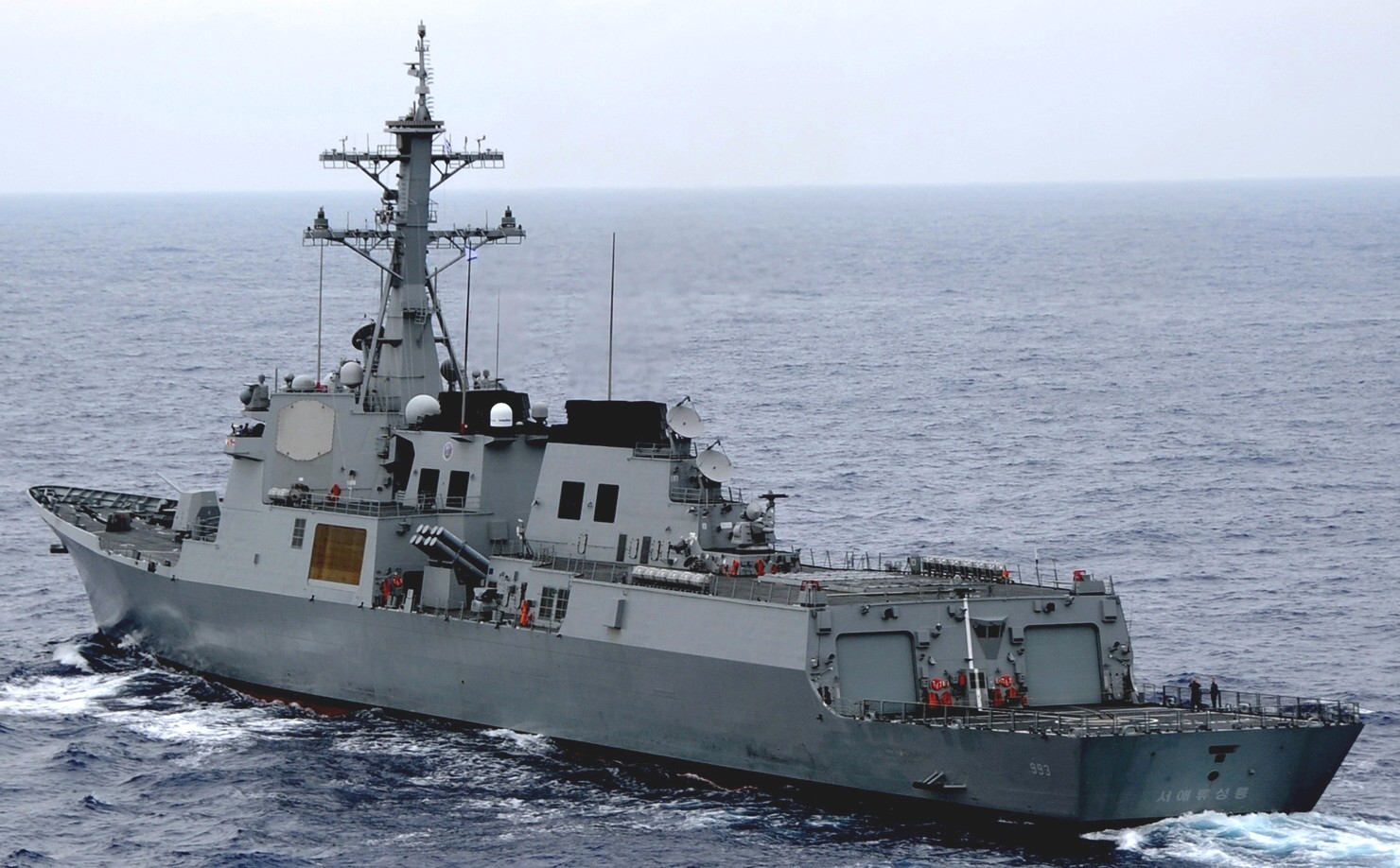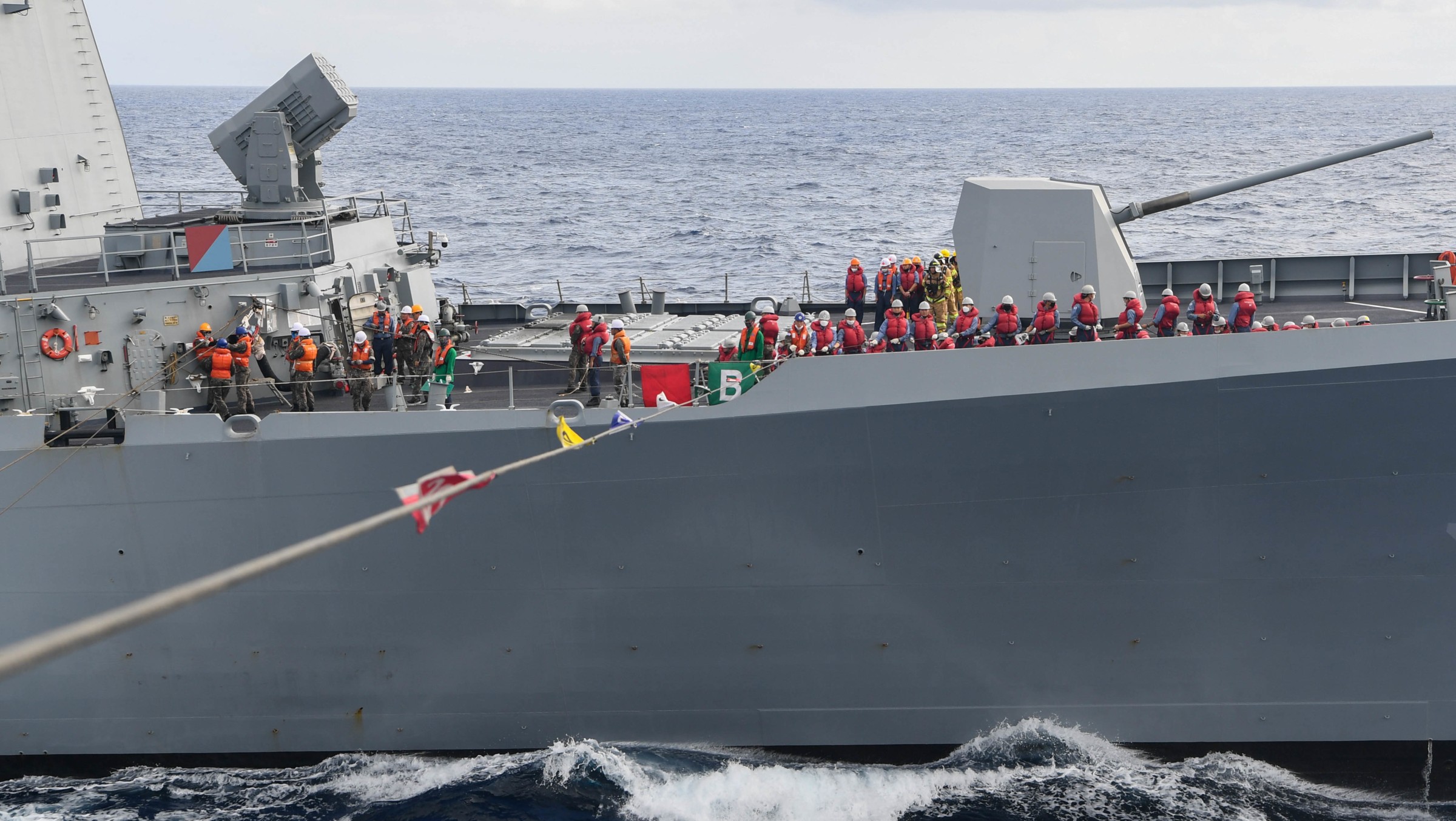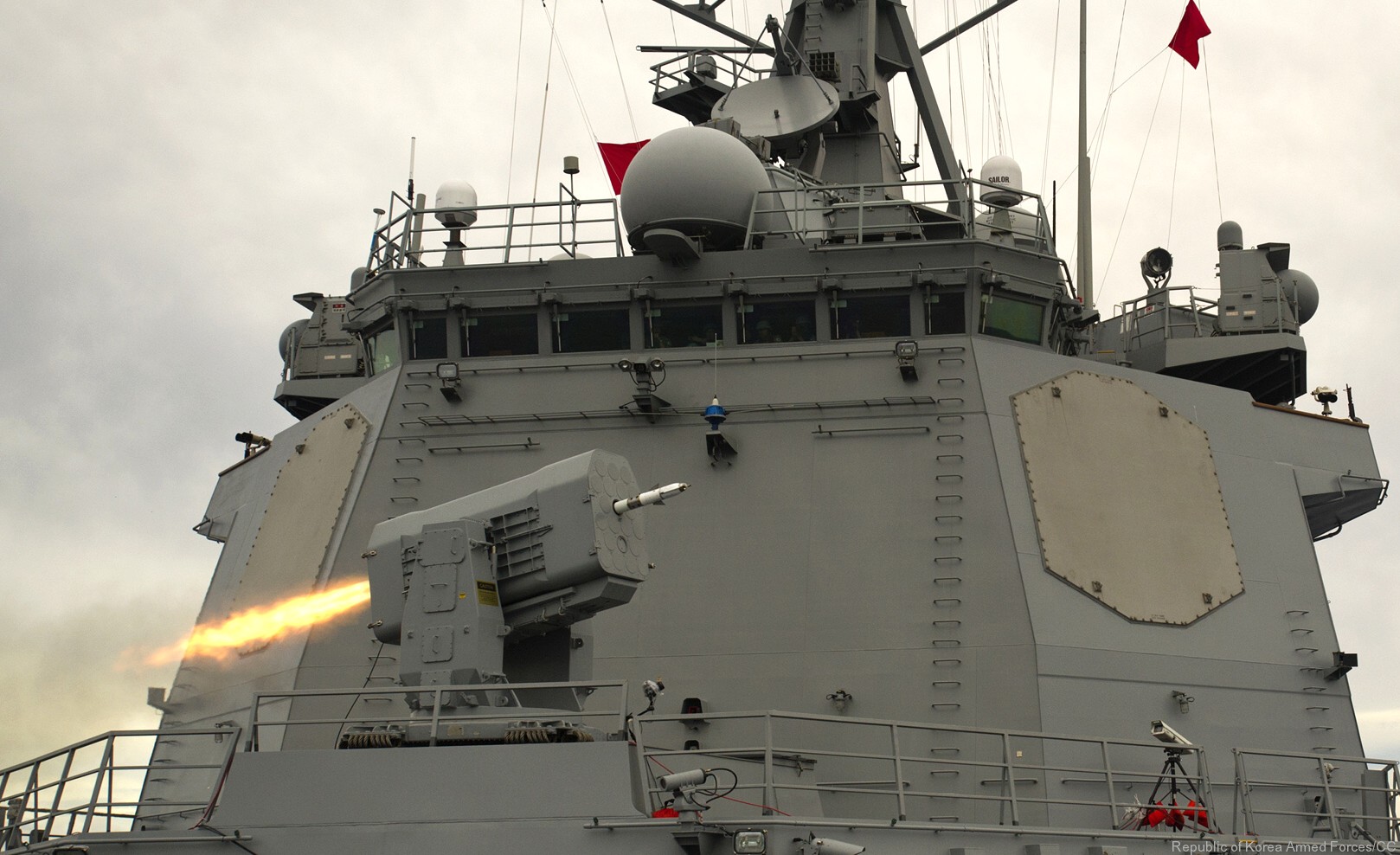|
|
|
HOME
|
US Navy -
ships
|
US Navy - air
units
|
USMC - air
units
|
International
Navies
|
Weapon Systems
|
Special Reports |
|
Republic of Korea Navy - ROKN Sejong the Great class (KDX-III) Guided Missile Destroyer |
 |
| 11/23 |
| Ships: |
|
Batch I: DDG-991 ROKS Sejong the Great (2008) DDG-992 ROKS Yulgok Yi I (2010) DDG-993 ROKS Seoae Ryu Seong-ryong (2012) Batch II: DDG-995 ROKS Jeongjo the Great |
| Specifications: |
|
Displacement: 8500 tons (standard) / 11000 tons (full load) Length: 166 meters (544 feet 7 inches) Beam: 21.4 meters (70 ft 3 in) Draft: 6.25 meters (20 ft 6 in) Speed: 30+ knots (56+ km/h) Range: 5500 NM (10200 km) Complement: 300 Propulsion: COGAG (Combined Gas and Gas) 4 x General Electric LM2500 Gas Turbines 2 shafts, 2 controllable pitch propellers 75000 kW (100000 shp) total power Armament: Mk. 41 Vertical Launching System (VLS) - 80 cells (48-cell forward / 32-cell aft) for RIM-66 Standard Missile SM-2MR Block IIIB/IV Korean Vertical Launching System (K-VLS) - 48 cells, aft for K-ASROC Red Shark Hyunmoo III Land Attack Cruise Missiles - - - - - 1 x Mk. 45 Mod. 4 gun (5-inches/127 mm/L62) 1 x Goalkeeper CIWS 1 x Mk. 31 GMLS for RIM-116 Rolling Airframe Missiles (RAM) 16 x SSM-700K Haeseong Anti-ship Missiles (SSM) in tube launchers (4x4) 2 x triple torpedo tubes for K745 Blue Shark torpedo Aviation: flight deck & hangar for 2 helicopters (Westland Lynx / AW159 Wildcat / MH-60R Seahawk) Systems: AEGIS Combat System (Baseline 7 Phase 1) AN/SPY-1D(V) multi-function radar AN/SPG-62 fire control radar DSQS-21BZ-M hull mounted sonar SQR-220K towed array sonar system Sagem Infrared Search & Track (IRST) system SLQ-200K Sonata electronic warfare suite |
|
|
|
The Sejong the Great-class destroyers (Sejongdaewang-Geup Guchukam
or Hangul: 세종대왕급 구축함, Hanja: 世宗大王級驅逐艦), also known as KDX-III, are
three guided missile destroyers of the Republic of Korea Navy
(ROKN). The ROKN has deployed three ships with an option for three
more which was taken up in December 2013. Background: The ship features the Aegis Combat System (Baseline 7 Phase 1) combined with AN/SPY-1D multi-function radar antennae. The Sejong the Great class is the third phase of the South Korean navy's Korean Destroyer eXperimental (KDX) program, a substantial shipbuilding program, which is geared toward enhancing ROKN's ability to successfully defend the maritime areas around South Korea from various modes of threats as well as becoming a blue-water navy. At 8,500 tons standard displacement and 11,000 tons full load, the KDX-III Sejong the Great destroyers are by far the largest destroyers in the South Korean Navy, and indeed are larger than most destroyers in the navies of other countries. and built slightly bulkier and heavier than Arleigh Burke-class destroyers or Atago-class destroyers to accommodate 32 more missiles. As such, some analysts believe that this class of ships is more appropriately termed a class of cruisers rather than destroyers. KDX-III are currently the largest ships to carry the Aegis combat system. Armaments: Sejong the Great-class destroyers' main gun is the Mk. 45 Mod. 4 (127 mm/L62) naval gun, an improved version of the same gun used on other warships from several other nations. Point-defense armaments include one 30 mm Goalkeeper CIWS and a RIM-116 Rolling Airframe Missile Block 1 21-round launcher, the first Aegis platform to carry RAM. Anti-aircraft armament consists of SM-2 Block IIIA and IIIB in 80-cell VLS. Block IIIB has added infrared (IR) induction mode to Block IIIA, improving cruise missile interception capability. Anti-submarine warfare armaments consists of both K-ASROC Hong Sang-uh (Red Shark) anti-submarine rockets which has same form to the U.S. ASROC. and 32 K745 LW Cheong Sang-uh (Blue Shark) torpedoes. Anti-ship capability is provided by 16 SSM-700K Hae Sung (Sea Star) long-range anti-ship missile, each with performance similar to the U.S. Harpoon. It is equipped on a navy ship that is built after the late KD-2 class destroyer. Land-attack capability is provided by the recently developed Hyunmoo-3C (Guardian of the Northern Sky) cruise missile, which is similar to the U.S. Tomahawk. Capabilities: The Sejong the Great-class destroyers are often compared to the Arleigh Burke and Atago classes because they utilize the AN/SPY-1 multi-function radar, have similar propulsion and capabilities. One notable difference between the Sejong the Great-class ships and Arleigh Burkes is the number of VLS cells. Destroyers of the Sejong the Great-class have a capacity of 128 missiles, as opposed to 96 on the Arleigh Burke class and the Japanese Atago-class destroyers. The Sejong the Great class is thus one of the most heavily armed ships in the world, with even greater missile capacity than the Chinese People's Liberation Army Navy Type 055 destroyer (112 VLS cells), or the U.S. Navy Ticonderoga-class guided missile cruiser (122 VLS cells), and considering only surface ships is surpassed only by the Kirov-class battlecruiser with 352 missiles (entire missile load). The four American Ohio-class submarines converted to guided-missile configuration carry 154 cruise missiles each. Another similarity to Arleigh Burke Flight IIA and Atago-class destroyers is the presence of full facilities for two helicopters, a feature missing from earlier Arleigh Burke and Kongō-class destroyers. These destroyers have the capability to track and monitor missiles launched from anywhere in North Korea. This capability was demonstrated by the tracking of a North Korean missile in April 2009. BMD: In August 2016, press reports revealed that South Korea was considering adding the SM-3 interceptor to its Sejong the Great-class ships to enable them to perform ballistic missile defense in response to North Korean efforts to bolster offensive missile capabilities. This comes just months after the U.S. decision to deploy the THAAD missile interceptor system on mainland South Korea. The addition of SM-3s to the ships may require software and computer hardware upgrades. The following month, Aegis manufacturer Lockheed Martin confirmed the next three Sejong the Great vessels will be capable of performing "integrated air and missile defense" (IAMD) to supplement U.S. Army ground-based missile interceptors on the peninsula, likely being outfitted with the SM-3. While the first three destroyers are fitted with Aegis Baseline 7 based on older proprietary computers that can't carry out IAMD operations, the following three will be fitted with the Baseline 9 version of the Aegis Combat System that combines modern computing architecture to allow the AN/SPY-1D(v) radar to perform air warfare and BMD missions at the same time. On 10 December 2013, the ROKN confirmed ordering three more vessels on the same class. On 10 October 2019, HHI signed a deal to build the first of three 170m long, KDX-III Batch II Aegis destroyers for the Republic of Korea Navy. Under the deal, HHI will deliver the first ship by November 2024. source: wikipedia |
|
images for more images go to the individual ship's page |
 DDG-991 ROKS Sejong the Great  DDG-992 ROKS Yulgok Yi I  DDG-993 ROKS Seoae Ryu Seong-ryong ARMAMENT + DETAILS  Mk.45 gun / Mk.41 VLS (48 cells) / RIM-116 RAM launcher  tube launchers (4x4) for SSM-700K Haeseong Anti-ship Missiles (SSM) / 2 x AN/SPG-62 fire control radar / Goalkeeper CIWS  RIM-116 RAM launcher / Mk.41 VLS (48 cells) / Mk.45 gun  32-cell Mk.41 VLS and 48-cell K-VLS, aft  tube launchers (4x4) for SSM-700K Haeseong Anti-ship Missiles (SSM) / 2 x AN/SPG-62 fire control radar / Goalkeeper CIWS  32-cell Mk.41 VLS and 48-cell K-VLS, aft  RIM-116 RAM launcher / Mk.41 VLS (48 cells) / Mk.45 gun  a RIM-66 Standard Missile SM-2MR was fired from the forward Mk.41 VLS  a RIM-116 Rolling Airframe Missile (RAM) was fired from the 21-cell launcher     |
|
|
seaforces.org
|
Republic of Korea
Navy start page
| |
